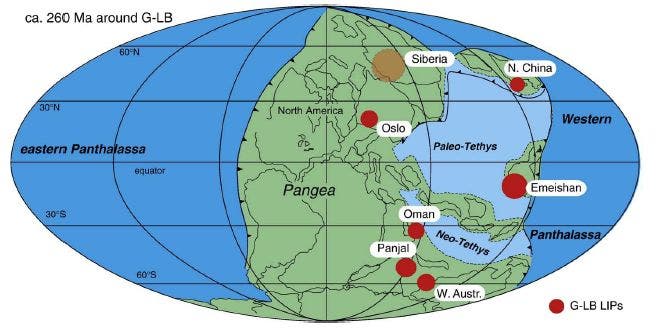- The Permian extinction was the biggest extinction ever, killing 96% of all marine species and 70% of terrestrial vertebrates
- Possible causes include: impact, loss of oxygen and volcanic eruptions
- Researchers tested the validity of the last hypothesis, finding it likely
The biggest extinction – ever
MIT Researchers believe that rain as acidic as undiluted lemon juice may have contributed to massive extinction that took place at the end of the Permian, 252 million years ago. These acidic rains may have played a part in killing off plants and organisms around the world during what is regarded as the most severe extinction the world has ever gone through.
It was so severe that it killed 96% of all marine species and 70% of terrestrial vertebrate species – and it took life about 10 million years to recover from it!
Pin-pointing the exact cause (or causes) of the Permian–Triassic extinction event is a difficult undertaking because it took place so long ago that most of the evidence was destroyed, eroded or buried away. There’s a major scientific debate, centering on several potential causes:
– an asteroid impact, similar to what wiped off the dinosaurs at the end of the Mesozoic
– a gradual, global loss of oxygen in the oceans
– a host of environmental changes caused by massive volcanic eruptions in today’s Siberia.
Now, researchers at MIT have simulated the final possibility. They created a climate model for a Permian world in which massive eruptions took place, ejecting volcanic gases (including sulfur) into the atmosphere. They found that if this were the case, then sulfur emissions were significant enough to create widespread acid rain throughout the Northern Hemisphere, with pH levels reaching 2 — as acidic as undiluted lemon juice. These acidic rains alone would have been enough to maim virtually all living plants, halting their growth and development, ultimately leading to the massive extinction.
“Imagine you’re a plant that’s growing happily in the latest Permian,” says Benjamin Black, a postdoc in MIT’s Department of Earth, Atmospheric and Planetary Sciences. “It’s been getting hotter and hotter, but perhaps your species has had time to adjust to that. But then quite suddenly, over the course of a few months, the rain begins to sizzle with sulfuric acid. It would be quite a shock if you were that plant.”
Volcanoes in Siberia

The world at the time of the Permian extinction. Highlighted are the biggest igneous provinces – notice Siberia. Source
It’s hard to wrap your mind around such a dramatic event as this one, and in a way, it’s hard to believe that it was just a single cause – it seems pretty likely that at least a couple of separate, unfortunate elements converged towards this extinction. Geologists analyzing the rocks in Siberia found evidence of immense volcanism that came in short bursts beginning near the end of the Permian period and continuing for another million years. The volume of the magma was several million cubic kilometers, enough to put a thick cover over all the United States. But even so, were these eruptions enough on their own?
The group simulated 27 scenarios, each approximating the release of gases from a plausible volcanic episode, including a wide range of gases in their simulations, based on estimates from chemical analyses and thermal modeling. They then modeled the interaction between these gases and the atmosphere, ultimately, how they were absorbed and then came down as low pH rain.
They found that with repeated bursts of volcanic activity, the acidic rains had a dramatic effect on land plants, probably going way past the point they could handle.
“Plants and animals wouldn’t have much time to adapt to these changes in the pH of rain,” Black says. “I think it certainly contributed to the environmental stress which was making it difficult for plants and animals to survive. At a certain point you have to ask, ‘How much can a plant take?’”
Now, Black hopes paleontologists and geochemists will consider his own results and compare them with their own observations of the Permian extinction, in order to paint a more accurate picture.
“It’s not just one thing that was unpleasant,” Black says. “It’s this whole host of really nasty atmospheric and environmental effects. These results really made me feel sorry for end-Permian organisms.”










